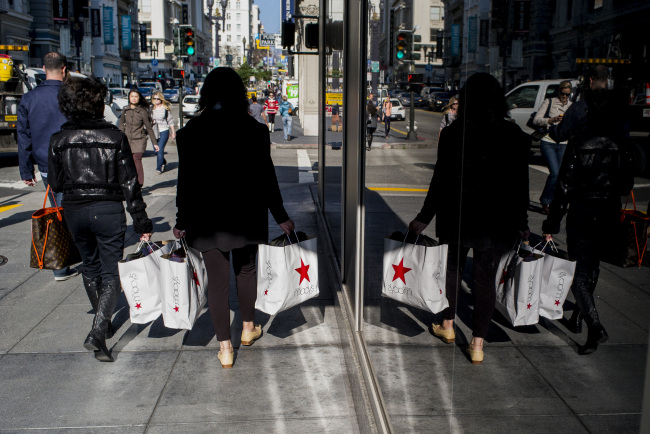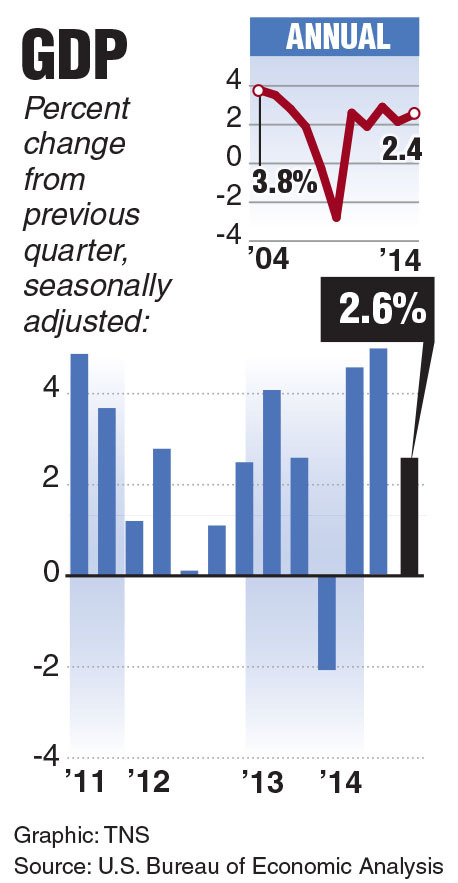WASHINGTON (AP) ― There’s a good reason the U.S. economy is impressing the world right now despite a slowdown in the final three months of 2014: In a word, steadiness.
Companies have been hiring at healthy rates for the past year. Layoffs hover near historic lows. Auto sales are strong. Gas prices have sunk. Congressional budget fights have faded. Americans are increasingly confident.
All that fed a surge of consumer spending last quarter, offsetting weaker business spending caused in part by a pullback by oil drillers and a frail global economy.
 |
Pedestrians carry Macy’s shopping bags in San Francisco, California. (Bloomberg) |
The U.S. economy as a whole expanded at a 2.6 percent annual rate, the government said Friday, down from a sizzling 5 percent gain the previous quarter. Yet consumers signaled their optimism by spending at the fastest rate in nearly nine years.
“This hasn’t changed my picture on the strength and resilience of the U.S. economy,” said Scott Anderson, chief economist at the Bank of the West. “Almost all the drivers of consumer spending are pointing in the right direction.”
Nearly six years into the recovery from the Great Recession, the economy has finally gone from straining just to grow to posting consistently solid gains. The gains have come even though many households continue to struggle without much of a financial cushion. Nearly half say they spend all their income, go into debt or use savings to meet their expenses, a new analysis by the Pew Charitable Trusts has found.
In addition, a surging dollar is denting the earnings of U.S. companies that operate overseas. And energy firms have been hurt by plummeting oil prices, and as a result companies in the Standard & Poor’s 500 index are expected to report weak profit growth.
But collectively, consumers and investors are showing renewed faith in the economy.
On Friday, the University of Michigan said its sentiment index found that U.S. consumers are more confident than they’ve been since 2004. Also Friday, the government said wages and benefits are ticking up, a sign that steady job gains may be compelling employers to pay a bit more.
Most indicators suggest that the economy has surpassed a psychological threshold that has made businesses more comfortable with hiring and infused consumers with more enthusiasm.
“Psychology has been a big contributor to the improved level of performance in the United States,” said Carl Tannenbaum, chief economist at the bank Northern Trust.
At a time when Europe, Asia and South America face deep anxieties, the U.S. economy’s greatest strength might be its remarkable sturdiness.

The consensus expectation is that the U.S. economy will expand a solid 3 percent this year, well above the recovery’s 2.2 percent annual average. This has made U.S. stocks and Treasurys comparably attractive ― havens from the risks from Europe’s prolonged slump, collapsing oil prices, China’s slowdown and Japan’s struggles to stave off recession.
Yet the U.S. economy still has additional room to continue expanding. In current dollars, the median household income of $54,417 remains about $1,800 below its late 2007 levels, according to Sentier Research. More than 5 million households owe more on their mortgages than their homes are worth, according to the real estate data firm CoreLogic.
Because the U.S. economy is rebuilding its core without relying heavily on mortgages, credit cards and other debt, it has avoided the sharp swings and shocks that can tip an economy into recession.
“You’re getting solid consistent growth,” said John Canally, chief economic strategist at LPL Financial. “If you have a slow recovery, you don’t build up the excesses that ultimately cause a recession.”
The gourmet hamburger chain BurgerFi plans to nearly double in size from its more than 60 restaurants this year. More consumers are upgrading from fast food, and the chain can choose from towns and cities “where the economic train has been rolling along at a pretty rapid pace,” said Corey Winograd, CEO of the Florida-based chain.
If all goes as planned, BurgerFi will account for 2,000 new jobs this year.
Investors are still trying to adjust for this newfound steadiness. The rush of foreign money into U.S. Treasurys has cut the yield on 10-year note to about 1.67 percent from 2.9 percent a year ago. A result is that it’s now cheaper for companies and homebuyers to borrow in ways that nurture growth.
During 2014, employers added an average of 246,000 jobs a month. That figure has remained above 200,000 for the past 11 months and has helped whittle the unemployment rate to 5.6 percent from 6.7 percent 12 months earlier. Given that applications for unemployment benefits have stayed consistently below a weekly average of 300,000, most economists think hiring should grow at a pace similar to the 2014 levels.
Wages have yet to grow significantly. But all those new jobs mean that the U.S. economy entered 2015 with an extra $126 billion in combined annual paychecks. That money has trickled into restaurant dinners, new cars and other goods and services.
Sales of new vehicles climbed 6 percent to 16.5 million last year, according to Autodata Corp. Car buying is poised to eclipse 17 million for the first time in a decade. Spending at restaurants and bars improved 5.8 percent last year, the government says.
Cheaper energy has been a gift for consumers, who account for nearly 70 percent of all U.S. economic activity. The Energy Information Administration projects that an average U.S. household will save about $750 this year on gasoline.
At the same time, Tannenbaum of Northern Trust cautions against becoming too complacent if consumers begin to fear that the economic woes abroad threaten the U.S. job market or financial markets.
“Psychology could also be the avenue through which some of the world’s uncertainties drag us back to growth that’s a bit less desirable,” he said.









![[Today’s K-pop] Blackpink’s Jennie, Lisa invited to Coachella as solo acts](http://res.heraldm.com/phpwas/restmb_idxmake.php?idx=644&simg=/content/image/2024/11/21/20241121050099_0.jpg)